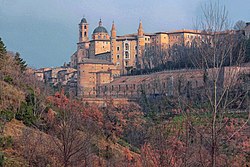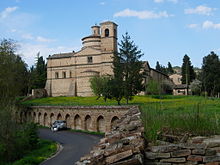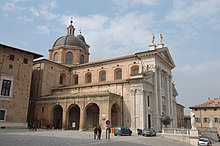Urbino
Urbìn (Romagnol) | |
|---|---|
| Comune di Urbino | |
 | |
| Coordinates: 43°43′N 12°38′E / 43.717°N 12.633°E | |
| Country | Italy |
| Region | Marche |
| Province | Pesaro and Urbino (PU) |
| Frazioni | Ca' Mazzasette, Canavaccio, Castelcavallino, La Torre, Mazzaferro, Pieve di Cagna, San Marino, Schieti, Scotaneto, Trasanni |
| Government | |
| • Mayor | Maurizio Gambini |
| Area | |
| • Total | 226.50 km2 (87.45 sq mi) |
| Elevation | 451 m (1,480 ft) |
| Population (30-4-2017)[2] | |
| • Total | 14,786 |
| • Density | 65/km2 (170/sq mi) |
| Demonym | Urbinate(i) |
| Time zone | UTC+1 (CET) |
| • Summer (DST) | UTC+2 (CEST) |
| Postal code | 61029 |
| Dialing code | 0722 |
| Patron saint | St. Crescentinus |
| Saint day | June 1 |
| Website | Official website |
| UNESCO World Heritage Site | |
|---|---|
 The church of San Bernardino near Urbino | |
| Criteria | Cultural: ii, iv |
| Reference | 828 |
| Inscription | 1998 (22nd Session) |
| Area | 29.23 ha |
| Buffer zone | 3,608.5 ha |



Urbino (UK: /ɜːrˈbiːnoʊ/ ur-BEE-noh,[3] Italian: [urˈbiːno] ; Romagnol: Urbìn) is a comune (municipality) in the Italian region of Marche, southwest of Pesaro, a World Heritage Site notable for a remarkable historical legacy of independent Renaissance culture, especially under the patronage of Federico da Montefeltro, duke of Urbino from 1444 to 1482.
The town, nestled on a high sloping hillside, retains much of its picturesque medieval aspect. It hosts the University of Urbino, founded in 1506, and is the seat of the Archbishop of Urbino. Its best-known architectural piece is the Palazzo Ducale, rebuilt by Luciano Laurana.
- ^ "Superficie di Comuni Province e Regioni italiane al 9 ottobre 2011". Italian National Institute of Statistics. Retrieved 16 March 2019.
- ^ "Popolazione Residente al 1° Gennaio 2018". Italian National Institute of Statistics. Retrieved 16 March 2019.
- ^ "Urbino". Lexico UK English Dictionary. Oxford University Press. Archived from the original on 2020-11-27.



